Matador Network's Blog, page 605
August 20, 2021
A look inside Cartagena’s Embassy of Salsa Music, a must-visit for any music lover
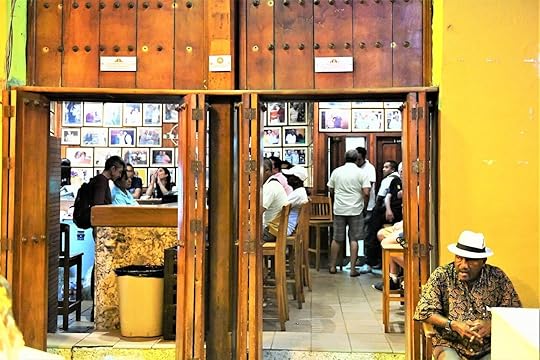
Anyone who hass seen a “Best Bars” list for Cartagena, Colombia, has likely noticed that Donde Fidel always figures prominently. The “Embassy of Salsa” in Cartagena is nothing less than a landmark in its own right. It’s an iconic old-school salsa joint that draws everyone from visiting tourists to international music stars who gather for a fun-filled fiesta that usually includes dancing with strangers.
Located inside the clock tower and right on the Plaza de Los Coches, which buzzes with nocturnal activity every night, Donde Fidel occupies three full storefronts. It’s always packed, even when Cartagena is having a dead night. Stepping into the bar is like entering another world. The intense hustle of tour salespeople and souvenir vendors gives way to the soul-soothing syncopated sounds of classic salsa while friendly faces that span multiple generations offer up welcoming smiles.
The secret to Donde Fidel’s vibe and unparalleled success is, of course, Fidel Lotteau himself, the bar’s namesake and a constant presence seven nights a week.
“The name Donde Fidel is a reference point in this city, and it’s a reference to both me and this salsa bar,” Lotteau tells me one early Wednesday night as the bar slowly starts to warm up. “It simply means ‘where Fidel is’ — and I am always here.”
Sitting against the wall and wearing a brightly striped polo shirt, he is backed by endless photos of himself posing with different salsa stars from all over the world. In every picture, he wears a brightly striped polo shirt of different color combinations.

Photo: Ocean Malandra
First opened in 1985 in Getsemani, the historic barrio just outside of the Old City that was once home to the walled Colonial seaport’s lower classes, Donde Fidel started as a neighborhood salsa bar. But it soon became famous among international travelers looking for an authentic experience in Cartagena, a place to rub shoulders with locals, immerse in Colombia’s music culture, and try their feet on the dance floor.
Realizing that he had a good thing going, Lotteau decided to move over to the Old City in the late 90s and put up digs in a choice location. Besides the three indoor rooms, the bar also operates four rows of outside tables backed by the ancient stone walls that once protected Cartagena from pirates. People watching is some of the best in the entire city here, and salsa spills out of the bar onto the patio.
“What we have created is something that I believe is very special, a kind of place where there are no vices or perversions, where there is no discrimination or racism,” Lotteau says. “The white and the black and the yellow or whatever color all mix equally here.”

Photo: Ocean Malandra
“People tell me that after being here for just an hour or so, they get this strange feeling that they have been coming here all their life.” Lotteau says. “They come by themselves, or with their partner, or friends, or family, and instantly become part of something larger.”
As the bar starts to pack with people, couples begin dancing to their favorite songs. Tourists look on while the house DJ starts racking up the selection for the night. Yellow-polo-shirt sporting servers weave between the tables and bar, keeping everyone well lubricated.
“Donde Fidel is a place where you are free, it is a temple of sorts, and it is a temple of this music called salsa that at its very roots is meant to inspire happiness and connection between people,” says Lotteau. Explaining that salsa transcends national and cultural barriers is why it is so important for him to act as an “ambassador” of it for visitors to Cartagena.
“I always say that where they listen to salsa is always a good place to be,” he says. “Why? Because salsa is a genre that is special in that it is full of good feelings. The salsa comes from a time some 70 or 80 years ago and is grounded in certain principles, these principles include respect. Respect for your fellow human, respect for the whole world.”

Photo: Ocean Malandra
Salsa music was born in Cuba in the early 1900s and was influenced by people in Puerto Rico and immigrants in New York. The Caribbean and Latin American nations created this new sound like a kind of stew, or “salsa,” of ingredients with slightly different but similar backgrounds. Full orchestras include horns, pianos, guitars and many other Western instruments, and it’s all driven by an array of African-influenced percussion instruments like the Conga drum. It quickly took the world by storm, pumping this infectious, happiness-producing rhythm into every corner of the globe.
Colombia has always been one of the most prolific salsa producing nations, and although the city of Cali, the “World Capital of Salsa” takes things to a whole other level in terms of salsa-fanaticism, other major cities like Bogota, Medellin, and of course Cartagena are all centers of salsa in their own right. In fact, the country’s most famous salsa singer, Joe Arroyo, whose anti-racism hit “La Rebelion” still gets constant airplay in salsa bars around the world, is a native son of this UNESCO World Heritage city.
“What’s really amazing is that salsa seems to be getting more popular than ever lately,” Lotteau says. “And so this place has become a magnet for the movement.” He adds that salsa stars from all over the world like to come to his bar when they’re in town for a big concert, and often come on their night off just to hang out. He sweeps his hands toward the photo-covered walls to demonstrate his point.
“Many times they perform impromptu as they feel inspired, improvising or a cappella, and then they mix with the public,” he explains. “And it becomes a place where they too can become part of the pueblo again, even if they have 40 or 50 years as a star musician. They too like to become one with everyone else. “

Photo: Ocean Malandra
As the night wears on and the liquor wears in, some of the wallflowers — mostly international visitors — are now up and trying their stuff on the dance floor. Some kind of get it, others well, need a bit more practice. But the magic of salsa music, the sentiment that Lotteau is trying to capture and express, does seem to be this: salsa is a powerful medium for experiencing happiness, joy, and union with your fellow human being. All of that is on full display the night I visit Donde Fidel.
“And that is what gives me pleasure more than anything else,” Lotteau tells me. “To have a place where people come and have a nice time, and listen and learn about this form of music and feel they are part of it — because they are. Salsa is for everybody.” 
The post A look inside Cartagena’s Embassy of Salsa Music, a must-visit for any music lover appeared first on Matador Network.
This trendy Bozeman motel is perfect for remote work with low rates through winter
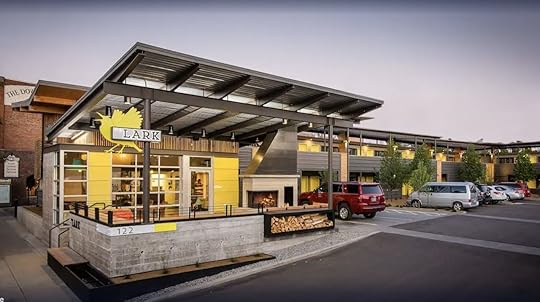
We hope you love the spaces and stays we recommend! Just so you know, Matador may collect a small commission from the links on this page if you decide to book a stay. Listed prices are accurate as of the time of publication. See our full Advertiser Disclosure here.
America is in the midst of a massive motel makeover the likes of which it hasn’t seen since the heyday of Route 66. Across the country, and especially in the West, motel and hotel properties once thought to be outdated and on their way to oblivion are being repurposed and retrofitted into hipster hangout havens. The best ones are not just crash pads, but entire social hubs that combine comfortable rooms with a vibrant lobby scene fueled by craft beer, local food, and easy access to the great outdoors.
In Montana, Bozeman’s The LARK is a prime example of this concept done extremely well. On any given evening, the lobby is full of young adventurers recounting the day’s excursion into the hills or out on the water. Inside the rooms, artwork inspired by the local landscape adorns the walls above spacious, clean beds. There’s room for your bike and your skis, but no room for clunky old furniture or bad vibes. Staying here is cozy and modern, with a nod to Montana’s rugged aesthetic, as well as the current trendiness of the hotel’s host city.
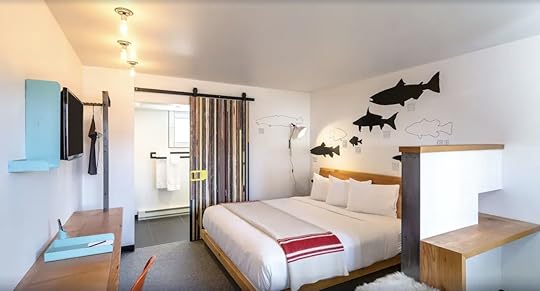
Photo: Expedia
The lobby of The LARK is outfitted to accommodate remote work and the modern lifestyle it allows for. The Wi-Fi is fast, the coffee strong, and the environment draws inspiration as much from the hard-working crowd as from the free-wheeling, feet-up lifestyle of adventure towns throughout the Rockies. The LARK is the ideal way to experience the new Bozeman, where locals and guests clock as many days on a mountain bike or kayak each year as they do on skis.
Everything in downtown Bozeman is within walking distance of The LARK’s Main Street location. You can walk to some of the city’s finest restaurants including Urban Kitchen and Revelry. Hop on a bike and hit Bozeman Taproom and Spirits or Montana Ale Works. And of course, Big Sky and the rest of the towering Madison Range is just an hour away.
Matador Network is excited to offer you rates as low as $135 per night at The LARK this fall and winter through Expedia. If you plan to take a fall or winter trip to the mountains of Montana, book this downtown Bozeman hotel now to get the best rate possible for your travel dates. 
Price: From $135
More like thisPaddlingThe ultimate floating tour through Montana, from Yellowstone to Glacier National ParkThe post This trendy Bozeman motel is perfect for remote work with low rates through winter appeared first on Matador Network.
If you’re a traveler or digital nomad, there’s a climate-friendly bank for you

This is the Climate Win, the most positive sustainability news around the world every week.
Whether you’re a traveler, digital nomad, or remote business owner, a new bank offers you remote banking in a way that lets you run your finances in a climate-friendly, socially conscious manner. Climate First Bank, which opened its first physical branch in St. Petersburg, Florida, this spring, is on a mission to be the largest values-aligned bank in the United States.
“What you know with certainty when you bank with Climate First is that your dollars will not be used for a handful of exploitative industries,” says Jared Meyers, Founding Director of Climate First Bank. “Additionally, a depositor would know that we purposefully and intentionally seek out positive loans.”
Meyers, a veteran entrepreneur who has founded two certified B-Corp businesses in the hospitality industry, joined forces with serial green bank founder Ken LaRoe to bring to life the notion that banking — and financial services in general — can be a force for good.
The bank’s loan model is built upon the ideas of Project Drawdown, a business and societal framework based on the ideas outlined by author Paul Hawkens in his book, Drawdown: The Most Comprehensive Plan Ever Proposed to Reverse Global Warming. Its mantra of removing carbon from the atmosphere and developing a society that prioritizes equitable values over profit appears to run counter to the common perception of banks. The very idea that a bank with plans for growth and expansion might keep outside factors in mind while doing so might come off as suspect.
Rightfully so. Rarely is news surrounding financial institutions a win for the environment. Bloomberg reported in April that the combined carbon emissions of the banking industry’s investment portfolios and loan programs — i.e. how they make money — is 700 times greater than that of their actual office operations and accounts for three percent of global carbon emissions.
Climate First Bank is a bank, first and foremost. Its board and founders acknowledge that it must make money. LaRoe said himself in a 2020 interview in the Orlando Sentinel that in addition to being an environmentalist, he is a “rabid capitalist.”
What stands out most about Climate First Bank is that its directors appear to have stumbled on a concept that has long eluded many self-proclaimed capitalists: that making money doesn’t have to come at the expense of the environment. Climate First is a Certified B-Corporation and a member of 1% for the Planet. It operates a climate-neutral business model. The bank does not invest in the fossil fuel industry or in other industries deemed harmful to the environment or social justice, as rated by the B-Corp certification and Drawdown frameworks.
Climate First gives its customers a chance to put their beliefs into action through its loan programs. Based on the principles of Project Drawdown, which outline a three-prong solution to the climate crisis including bringing emissions to zero, uplifting the carbon cycle, and supporting environmental justice, clients are able to obtain a lower rate on loans
“Thinking of your bank and your money counteracting all the work that you do every day is painful,” Meyers says. “I tried with a number of banks in Florida to be more responsible by asking them to work through the B-Corp framework. I wasn’t successful. So when Ken reached out to me about starting this bank, I said, ‘Absolutely, let’s do it.’”
Of particular pride to Meyers is Climate First’s solar loan program, which he believes is among the best in the country. The bank prioritizes loans financing projects such as EnergyStar or LEED-certified developments.
The bank’s first branch opened this spring in St. Petersburg, Florida, and the company plans to open further branches throughout central Florida and eventually beyond. Travelers who are not based in Florida can open a personal checking or savings account remotely. Those accounts can serve their general banking needs, and they can rest easy knowing that their deposits are simultaneously funding these positive projects.
“I hope we never become one of the bigger banks that treats their customers like an account number,” Meyers says.
More climate wins this weekA federal judge in Alaska blocked the approved construction permits for a massive oil and gas project in the state’s North Slope, The New York Times reported. The Willow Plan, as it was known, had been approved by the Trump administration and backed by the Biden administration. The judge ruled that its proposal had failed to note the project’s impact on wildlife and the climate.
The Environmental Protection Agency will ban the use of chlorpyrifos on food, The New York Times reported. Chlorpyrifos has been found to cause neurological harm to children, and the ban on its use as a pesticide on common grocery items will take effect in six months.
A new railway in the United Kingdom will be constructed using 3D-printed concrete, which is expected to reduce the carbon footprint of the project by nearly 50 percent. The first phase, from London to Birmingham, is slated to be complete in 2026, Construction Dive reported.
The post If you’re a traveler or digital nomad, there’s a climate-friendly bank for you appeared first on Matador Network.
This company will give you $3,000 to explore a top beer city

As the summer season is slowly but surely coming to an end, many people are getting ready for fall celebrations like Oktoberfest. However, travel restrictions are still in place in parts of the world, and many of the most famous Oktoberfests are again canceled this year. But one company is helping someone make their own perfect fall beercation by giving them $2,000 in bar tab money and $1,000 in travel expenses.
Move.org is seeking a “Chief Beer Baron” and footing the bill for someone to drink beer in one of America’s beer capitals to celebrate Oktoberfest.
As a Chief Beer Baron, you’ll get to choose one city from Move.org’s Best Cities for Beer Lover’s Report to visit and hit up as many breweries and beer bars as you responsibly can. The 10 cities to choose from are:
1. Portland, OR
2. Denver, CO
3. Cincinnati, OH
4. Richmond, VA
5. Spokane, WA
6. Seattle, WA
7. Tacoma, WA
8. Saint Louis, MO
9. Minneapolis, MN
10. Pittsburgh, PA
If you’re selected, you’ll receive $1,000 for your travel accommodations, $2,000 for all your hard work and dedication to your title, and $500 in moving expenses if you feel the vibe is right and want to move to that city (though it’s important to note that you don’t have to move). After you visit your chosen city, you’ll fill out a questionnaire to review the city’s beer scene based on its culture, beverages, and food.
Applications are open until September 10, and Move.org will choose an applicant for their Chief Beer Baron on September 15.
To apply, you must be 21 and over and eligible to work in the US, a beer enthusiast, and be ready to take your taste buds to the next level. If this sounds like the dream job for you and you want more information and to apply, you can visit the website. 
The post This company will give you $3,000 to explore a top beer city appeared first on Matador Network.
August 19, 2021
6 blissful boutique hotels in Maui you can still book this summer and fall
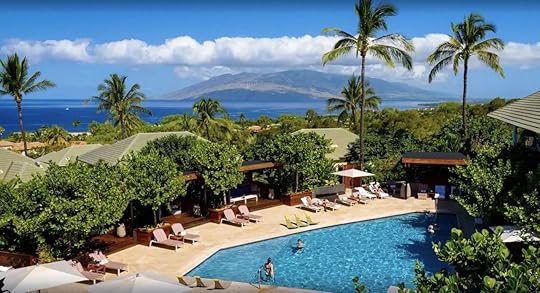
As summer comes to a close, the temptation to squeeze in a tropical getaway only intensifies. And where better to plan a last-minute beach vacation than Hawaii. With its sublime coastline, volcanic peaks affording visitors some of the most exciting outdoor recreation in the archipelago, and cultural and culinary scenes beyond compare, Maui is the island of choice for many travelers. Lucky for Valley Isle lovers, it’s not too late to snag a hotel for a late-season trip. Here are six scenic, idyllic boutique hotels in Maui you can still book this summer.
We hope you love the spaces and stays we recommend! Just so you know, Matador may collect a small commission from the links on this page if you decide to book a stay. Listed prices are accurate as of the time of publication. See our full Advertiser Disclosure here.
1. Lumeria Maui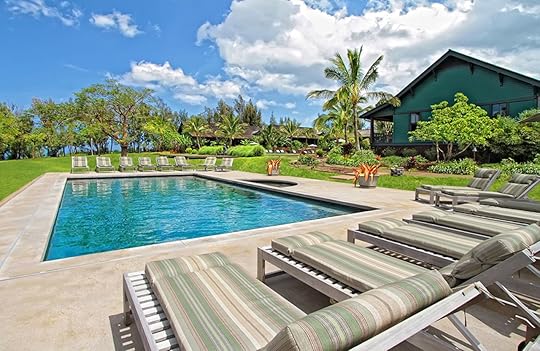
Photo: Lumeria Maui
Lumeria Maui is more than an accommodation. The historic property brands itself as an educational retreat center with a focus on well-being. Backdropped by five acres of lush gardens in the Upcountry region of Maui’s North Shore, guests can sign up for classes on topics ranging from yoga, meditation, healing arts, and metaphysical studies to Hawaiian culture, horticulture, movement, and dance. After finding enrichment, guests will enjoy farm-to-table nourishment at the on-site Wooden Crate restaurant and supreme rejuvenation at the healing hotel spa.
Price: From $386 per night
2. Montage Kapalua Bay
Photo: Expedia
This five-star Montage resort sits on 24 acres of Maui’s northwest coast. Nestled in Kapalua Bay, whose namesake beach has been called one of America’s finest, the property offers more than 50 residential-style suites and grand residences, plus five on-site restaurants, four bars, and a full-service spa. When they’re not lounging at the beach club or by the pool, guests can take hula, ukulele, or lei-making classes or attend a “talk story” session. The resort’s cultural ambassador can also arrange activities for kids and teens, from tide pooling to beach volleyball.
Price: From $2,186 per night
3. Ho’oilo House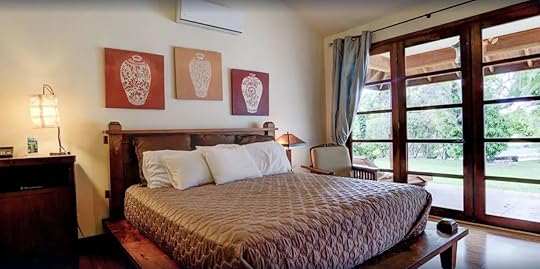
Photo: Expedia
Simple yet luxurious, Ho’oilo House is the stuff of Hawaiian bed-and-breakfast dreams. The property’s West Maui Mountains location is hard to beat, with easy access to downtown Lahaina and idyllic Kaanapali Beach. The sleepy surroundings are perfect for couples seeking a romantic getaway. But Ho’oilo House also caters to active types, with hiking, mountain biking, snorkeling, surfing, sailing, and golf at their fingertips. Guests can even rent a helicopter for an aerial tour of the island before retiring at the on-site spa.
Price: From $422 per night
4. Paia Inn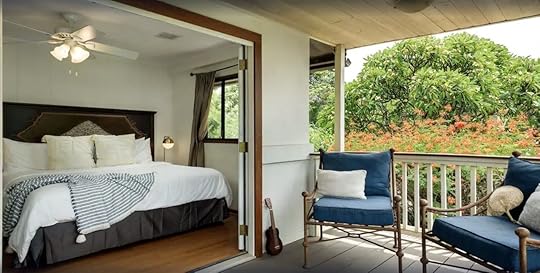
Photo: Expedia
A hit with surfers and trendsetters, Paia Inn puts a global spin on the classic Maui-style lodging. The property was designed with Balinese architecture in mind, and the on-site restaurant, VANA, captures Hawaii’s multiculturalism with a Japanese-heavy menu that serves everything from sushi to tapas crafted from locally sourced ingredients. Every room comes with private beach access, and guests are gifted guest passes to the nearby Fuzion Fit gym, which they can enjoy when they’re not doing downward dog on the shore or relaxing at the on-site spa.
Price: From $599 per night
5. The Old Wailuku Inn at Ulupono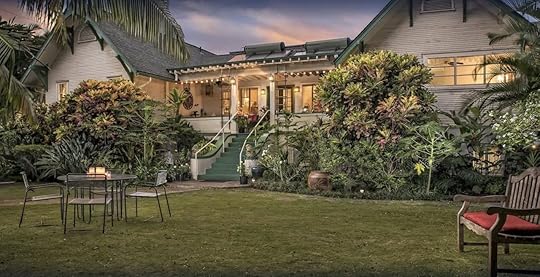
Photo: Expedia
The Old Wailuku Inn prides itself on offering guests a local experience in a relaxed, residential neighborhood of West Maui. The inn’s 10 guest rooms are cozy yet well-appointed. Each is equipped with a whirlpool tub where guests can wind down after busy days exploring Wailuku at the doorstep of the sacred ‘Īao Valley. Nature lovers can also visit Haleakala National Park, home to Maui’s highest peak, located roughly an hour and a half southeast on Highway 378.
Price: From $289 per night
6. Hotel Wailea
Photo: Expedia
An adults-only Relais & Châteaux resort that’ll make any couple’s trip feel like a honeymoon, Hotel Wailea boasts unparalleled island views from its hilltop perch 300 feet above the ocean. The 15-acre property is a maze of lush, serene spaces, from the sunset lawn to the tropical gardens and on-site waterfalls. Guests can sip tropical drinks at the alfresco cocktail lounge, sample seasonal ingredients and fresh-caught seafood at the open-air restaurant, and retreat to waterside cabanas when they want some private time. Better yet, the in-suite spa menu ensures a perfect end to any day spent exploring gorgeous Wailea Beach. 
Price: From $857 per night
More like thisWhere to Stay9 of the most breathtaking Airbnbs on MauiThe post 6 blissful boutique hotels in Maui you can still book this summer and fall appeared first on Matador Network.
Arapahoe Basin’s new via ferrata is the highest, and scariest, in North America
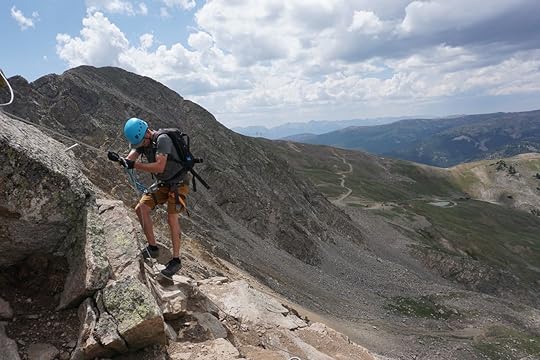
The highest, and likely most exciting, via ferrata in all of North America opened this summer at Arapahoe Basin ski area in the high Rockies of Colorado. It’s the most thrilling way to make the transition to outdoor climbing.
While indoor climbing at a gym is relatively safe and predictable, outdoor climbing can be intimidating. Mother Nature didn’t design the world’s rock faces and crags with perfectly placed hand- and footholds, after all. In a via ferrata, on the other hand, you’re harnessed and on the rock, much like trad climbing, but with the benefit of steel holds and a fixed steel line. Here’s what to expect at the record-breaking via ferrata at Arapahoe Basin.
What is a via ferrata, exactly?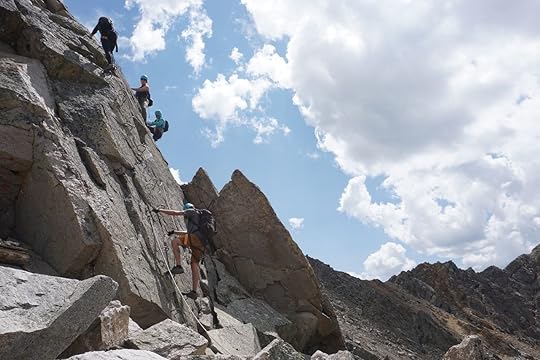
Photo: Thomas Beatty
Via ferrata means “iron way” or “iron path” in the Italian language. A via ferrata is a fixed climbing route set with steel anchors to assist where hand and footholds are noticeably absent. Additionally, the climber is connected by dual carabiners to their harness and a steel rope that runs the length of the course. The rope is anchored to the rock or wall every several feet en route. At each anchor point, the climber unbuckles their carabiners and re-buckles on the other side of the anchor, allowing them to progress along the route. This also prevents drastic and deathly falls — if you were to slip, you’d only fall as far as the last anchor point before the carabiners attached to your harness catch you.
In essence, a via ferrata is an ideal introduction to rock climbing and mountaineering because it exposes you to the moves, gear, and climate of these extreme sports, in an entry-level environment and with far less risk of serious injury.
While the origins of the via ferrata date back to the mid-19th century as a way to connect remote villages in the Dolomite range of northern Italy, it was during World War I that their construction and expansion began in earnest. When the Austro-Hungarian empire was battling Italy during World War I, they served to safely and quickly move soldiers across The Dolomites. During and even after the war, the use of these fixed climbing routes expanded across The Alps.
Via ferratas eventually spread to North America, increasing in popularity in the 2010s as a means for recreational users to experience mountains, canyons, and gorges previously only accessible to experienced alpinists. There are currently more than 3,000 via ferratas in the world, the vast majority of which are in Europe.
What it’s like to climb North America’s highest via ferrata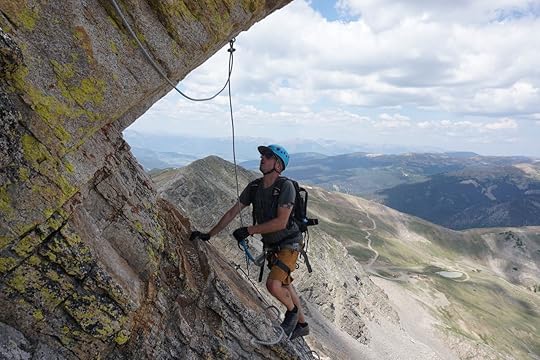
Photo: Thomas Beatty
I looked down at the four climbers behind me, each at a different stage of ascending the upper portion of Arapahoe Basin’s East Wall. The East Wall is an 800-foot-tall face of sheer granite that towers above the resort’s Lenawee Mountain Lift to a summit elevation above 13,000 feet. From this elevation and pitch, the open blue sky surrounding the climbers behind me was a pretty, if eerie, contrast to the rock we clung to — and the green and brown summer tint of ski runs cut through the pines below treeline were by now more than 1,000 feet beneath us.
The Arapahoe Basin via ferrata began with a ride up the Black Mountain Express lift to 11,550 feet in elevation. From here we walked a half-mile to the beginning of the via ferrata course, where our guide, Thomas Beatty, led a safety talk and carabiner practice session. Two of the five members of our team had never attempted a via ferrata — or any climb at all.
This was only my second outdoor climb, and it had been five years since I’d last strapped in. A bit rusty, I fumbled my way across Schoolhouse Rock, named as such for its position as the practice station, until I found a level of comfort with one hand on a steel ladder and the other coddling a small divot in the rock that served as a practice handhold. The others did the same. Within twenty minutes we were hooked into the course and heading up the East Wall.
If you’ve seen Tommy Caldwell’s ram-like crag prowess in The Dawn Wall, then you have a basic idea of what climbing looks like. Actual sport climbing is an extreme version of what it takes to climb the Arapahoe Basin via ferrata. While many of the fixed routes in Europe and the Americas consist mostly of quick vertical ascents interspersed with horizontal movements across a rock wall or canyon face, the climb at A-Basin is true to its name. It goes up — and although there are several places to stop on a flat surface for a sip of water and a moment of rest along the way, most of your time and physical effort is spent ascending steel ladders and working through tight crags.
To attempt this track, you should be in at least moderate shape and be comfortable exerting energy for four to six hours at altitude. A backpack, closed-toed shoes, and at least one liter of water are mandatory. Arapahoe Basin offers two excursions on the course, a half-day trip that reaches an old mine about halfway up the face, and the full-day climb we had embarked on that heads to the summit. All climbs are guided and consist of small groups of not more than five participants. The course is hair-raising, as you stare straight into the East Wall as you move from rung to rung, and each time you stop to look back, the ground is farther away. But it’s not extremely difficult. Within ten minutes, everyone in our group had become comfortable with moving the carabiners around the anchors. The basic climbing motions necessary to move up the course fall somewhere between scrambling up a steep, rocky hike and climbing a never-ending ladder.
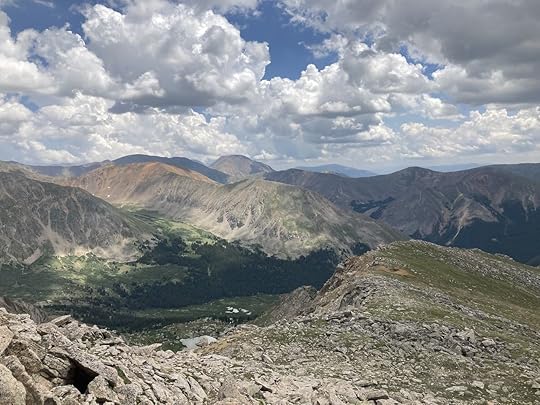
Photo: Tim Wenger
We stopped about halfway up the climb, having taken a little over an hour to reach the old mine that marks the high point of the shorter tour option. After a quick snack and water break, we were back at it. Our group took another 60 minutes to ascend the top portion of the climb, a much steeper section that involved more than a half-dozen separate pitches. The full route climbs 1,200 feet.
Climbing over the final stretch of granite to the summit, I pulled myself up and over and was greeted by a view that few have the privilege of experiencing, and even fewer outside of an airplane. The Rockies stretched out in all directions — 360 degrees of peaks from Buena Vista to the south, north to the Flat Tops near Steamboat Springs, with snow visible on some even in late July. Beatty, our guide, informed us that more than a dozen 14’ers — peaks above 14,000 feet in elevation — are visible from this spot depending on weather conditions across the high country. We counted seven that afternoon.
During the descent, climbers spend much of the downward portion in a sort of semi-rappel, gripping the steel rope with both hands as they move their feet down the face of the rock wall from rung to rung. The steel rope would undoubtedly skin your hands raw if you were to forget a pair of gloves. The descent takes less time than the ascent but is no less daunting. I spent much of the time facing the rock and looking down below my feet, identifying each next step as it approached. Once regrouped at the bottom of the wall, we hiked the half-mile back to the top of the lift.
This experience boosted my comfort on high-altitude rock faces and set the course for tougher, more legitimate mountaineering. For the true adventurer, the confines of a climbing gym can never satisfy the lust for that next summit. 
The post Arapahoe Basin’s new via ferrata is the highest, and scariest, in North America appeared first on Matador Network.
A UK man is sentenced to 6 weeks in Singapore jail for refusing to wear a mask

On Wednesday, British citizen Benjamin Glynn was sentenced to six weeks in jail for breaching Singapore’s strict anti-COVID rules — he refused to wear a mask.
Back in May, Glynn was caught on video riding a train maskless and telling other passengers he would never wear one. He was let out on bail and, at a July 2 court appearance, he showed up without a mask. CNN reports that Glynn was also causing a public nuisance and using threatening words toward public servants.
That resulted in further charges and Glynn, a UK citizen who had been working in Singapore, was then taken into custody in mid-July, pending trial on August 18.
At the one-day trial this week, Glynn represented himself and said he was a “living man” who had not signed a contract to wear a mask. To this, Judge Eddy Tham reportedly responded, “It is obvious to everyone in this courtroom that you are a living person.”
As Channel News Asia reports, the judge further told Glynn that he was “completely misguided” in his belief that he was exempt from Singapore’s laws on wearing masks. At the end of the trial, which included unruly behavior by a woman who also refused to wear a mask and claimed she was a “living, breathing woman,” the judge announced the six-week sentence.
Judge Tham backdated Glynn’s sentence to July 19, when the country first took him into custody. Glynn was also released for having served two-thirds of his sentence and is being scheduled for deportation. In addition to deportation, a spokesperson from the Ministry of Manpower (MOM) said it has “permanently banned” Glynn from working in Singapore.
Singapore’s strict COVID protocols don’t go unnoticed, and they are known for jailing and fining others for not obeying their strict protocols when it comes to COVID. In February, another British man was jailed for two weeks for sneaking out to meet his fiance while in quarantine. 
The post A UK man is sentenced to 6 weeks in Singapore jail for refusing to wear a mask appeared first on Matador Network.
How to plan the perfect autumn road trip through the Berkshires
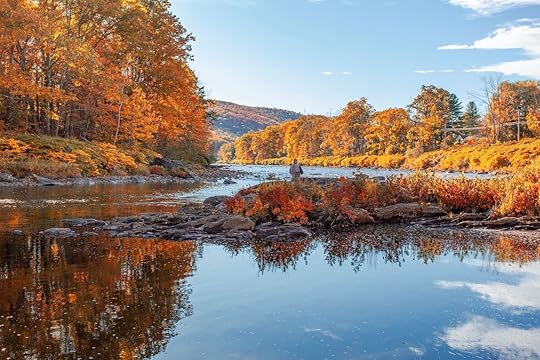
Thinking about fall in New England typically conjures wistful images of the vibrant colors found along Maine’s woodland roads. Maine is great, but its scenic northern regions can be difficult and inconvenient to access for a traveler strapped for time. The good news is that you don’t have to venture too far from Boston to experience the best of fall in New England.
Just under three hours west of the city, the Berkshires is a rural region in the mountains that’s defined by its rugged scenery and the bucolic villages scattered throughout the area. It’s the perfect destination for hiking, leaf peeping, and exploring historic towns, and its proximity to Boston makes it a manageable day trip for anyone near the city. Here are a few Berkshires road trip itineraries for any traveler looking to get the most out of fall in New England.
1. Southern and central BerkshiresThis route begins on Main Street in Great Barrington and follows Route 7 North over the Housatonic River. After the river, you’ll pick up Route 23 East, which leads into the mountains and woodlands that have proven popular among hikers and visitors looking for outdoor adventure. You’ll soon come to the town of Monterey where you can stop and explore the small community. From Monterey, head north to Tyringham, which is defined by its colonial farmhouses, before driving west to Stockbridge, which is famous for being the former home of artist Normal Rockwell.

Photo: Albert Pego/Shutterstock
You could easily spend the entire afternoon strolling the town’s historic Main Street, including the iconic Red Lion Inn, which has been open for more than two centuries. The town is also known for its stately summer cottages that were built by wealthy families during the Gilded Age of the late 1800s. Leave Stockbridge via 183 South and take the scenic ride back across the Housatonic River, which passes through the sleepy villages of Glendale, Housatonic, and Risingdale before ending where you started in Great Barrington.
2. Northern and central BerkshiresThis road trip begins in the historic Park Square in Pittsfield. From there, drive north on Route 7 passing Pontoosuc Lake and consider making a pit stop for the panoramic views. There are several public beaches and sail boat, jet ski, and canoe rentals here, so you could easily spend a whole afternoon relaxing by the lake if you’re not strapped for time. Continue on Route 7 until Route 8 North past Lanesboro, which you’ll follow through Cheshire and Adams. In Adams, it’s popular to take a bicycle along the Ashuwillticook Rail Trail that runs parallel to Route 8, with scenic views of the lake and mountains.
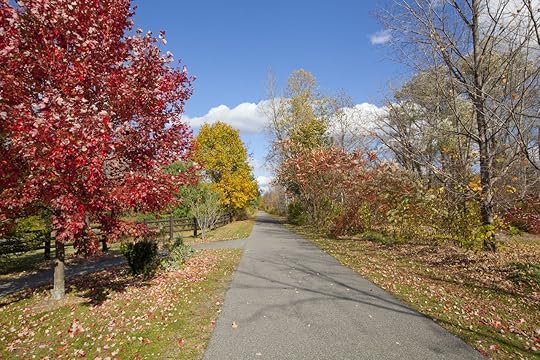
Photo: jdwfoto/Shutterstock
Upon leaving Adams, turn onto Route 116 East and plunge into the area’s rural farmlands and forests. Windsor Jambs and Windsor State Forest are popular areas for hiking and camping, and are particularly known for the dramatic waterfall tumbling next to Windsor Pond. Emerging from the forest, follow Route 9 South through the historic towns of Windsor and Dalton before returning to Pittsfield.
3. Southern BerkshiresThe Southern route through the Berkshires is one of the best for glimpsing fall foliage. This route through the mountainous back roads begins in Sheffield, the southernmost town of Berkshire Country. It’s also the oldest, settled in 1725. Once you’ve thoroughly explored Sheffield’s antique shops, head north on Route 7 to Great Barrington, then turn west onto Route 23 toward South Egremont. From here, follow Route 41 South to Mount Everett State Reservation and Bash Bish Falls, where you’ll find walking trails leading to stunning waterfalls. The reservation is one of the most popular destinations in the Berkshires for leaf peeping, with several trails around Mount Everett that are surrounded by the season’s changing colors.

Photo: Richard Cavalleri/Shutterstock
Returning to Route 7 and head south to the village of Ashley Falls, which is known for its historic preservation and nature trails, before continuing to Mill River, an old New England farming village that retains much of its colonial charm. From Mill River, simply follow Route 7 South back to Sheffield. This route is a perfect balance of historic towns and scenic views, taking you through some of the area’s most rural geography.
4. Mount GreylockThe highest point in Massachusetts, Mount Greylock is the ideal place for viewing the sweeping Berkshires region. But don’t worry, you don’t actually have to hike to the top. There are a few driving routes that afford visitors memorable and panoramic views of the area and the beauty of the mountain itself. One of the most popular driving routes begins just north of Lanesborough on Route 7. Rockwell Road leads 10 miles up to the top of the mountain, but don’t just make a beeline for the summit.
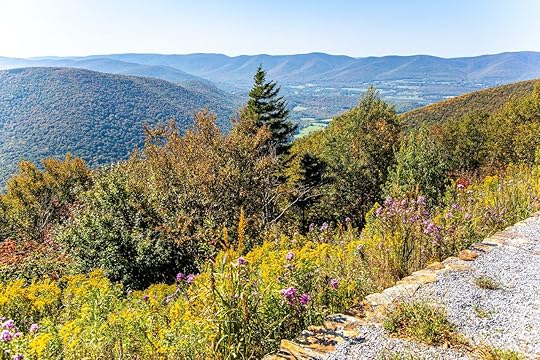
Photo: Katkami/Shutterstock
Partway up you’ll see a steep meadow, which is the southern slope of Saddle Ball Mountain. Several foot trails cross the summit of Saddle Ball Mountain and continue to cross Mount Williams and Mount Fitch to the north. The Cheshire Harbor Trail, which starts on West Mountain Road in Adams, is probably the most popular, so you can certainly spend plenty of time exploring this mountainous area before even thinking about summiting Mount Greylock.
As you continue on, you’ll come across the former location of New Ash Fort, which was once used against Native Americans in the 1760s. Heading farther uphill on Sperry Road, you’ll reach the Stoney Ledge lookout with views of the Hopper, a wooded canyon bisected by a brook. Back on Rockwell Road, you’ll finally reach a paved access to the summit of Mount Greylock, marked by the War Memorial Tower — a 90-foot granite tower built as a memorial to fallen Massachusetts soldiers. From here, you’ll have sweeping views of Mt. Monadnock in New Hampshire, the Green Mountains in Vermont, and the Adirondacks and Catskills in New York. 
The post How to plan the perfect autumn road trip through the Berkshires appeared first on Matador Network.
You can now stay in Costa Rica on a digital nomad visa for 2 years
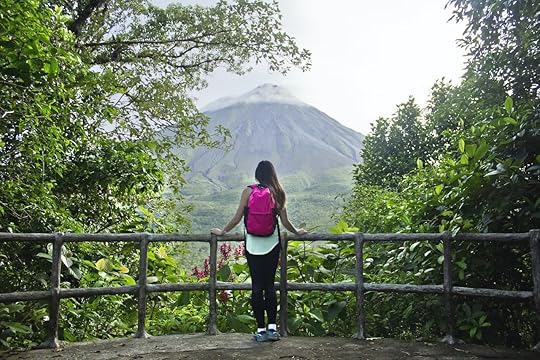
Following the trend of countries all over the world offering digital nomad visas, Costa Rica has recently announced its new digital nomad visa scheme.
The initiative was signed into law by President Carlos Alvarado on August 11, 2021. The digital nomad visa will allow remote workers to stay in the country for up to two years (one year renewable). Previously, remote workers entered the country as tourists and could only stay for 90 days.
In order to obtain Costa Rica’s digital nomad visa, remote workers will need to show proof of a stable monthly income of at least $3,000. If the applicant would like to apply with a partner or family member, the joint income must be $4,000 or more per month. Applicants must also obtain health insurance to cover all parties throughout the duration of their stay.
Digital nomad visa holders will be exempt from paying Costa Rican income taxes. They will also be able to open local bank accounts and drive in the country using their foreign license.
“Tourists who stay for longer periods of time redistribute their money in the value chains generated by tourism,” Tourism Minister Gustavo Segura said. “They make more local purchases, rent a car for several weeks or months, use services such as the beauty salon, the supermarket, restaurant, soda, laundry, greengrocer, medical services, among other businesses in the community, hence the importance of becoming an option for remote workers.”
The specifications of the visa application, including cost, have yet to be determined. The details must be laid out by the General Directorate of Migration and Foreigners (DGME) in no more than two months, as established by law. 
The post You can now stay in Costa Rica on a digital nomad visa for 2 years appeared first on Matador Network.
Everything you need to know about Quebec’s vaccination passport

Canada relaxed its travel restrictions on August 9 to allow fully vaccinated American tourists to enter the country. Though it’s a sign of progress, the country is still on a mission to increase the vaccination rate and limit the spread of COVID-19.
According to the Treasury Board of Canada Secretariat, as of August 13, “More than 71 percent of eligible people in Canada are fully vaccinated, and more than 82 percent have had their first shot. However, more than 6 million eligible people in Canada are still unvaccinated.” To make sure more people get immunized, Canada will soon require all air, train, and cruise ship passengers to be fully vaccinated before traveling.
Going one step further to avoid a fourth wave of COVID-19 cases and a possible lockdown, and following the lead of several European countries and New York City, the Canadian province of Quebec is implementing a vaccination passport. Scheduled to be implemented on September 1, 2021, Quebec’s vaccination passport will be needed to access non-essential services such as gyms, bars, restaurants, festivals, event venues like concert halls and sports stadiums, museums, etc. According to Global News, the vaccination passport will not be required to access retail stores, and it currently remains undecided if religious events and weddings will require one.
Quebec’s vaccination passport will be accessible through an app and have a scannable QR code. The QR code will not show any personal or medical information to those who scan it. The CBC explains that those who do not own smartphones will be able to use the paper vaccination certificate they were given when they were immunized, print out the QR code, or request a paper version by mail. 
The post Everything you need to know about Quebec’s vaccination passport appeared first on Matador Network.
Matador Network's Blog
- Matador Network's profile
- 6 followers



